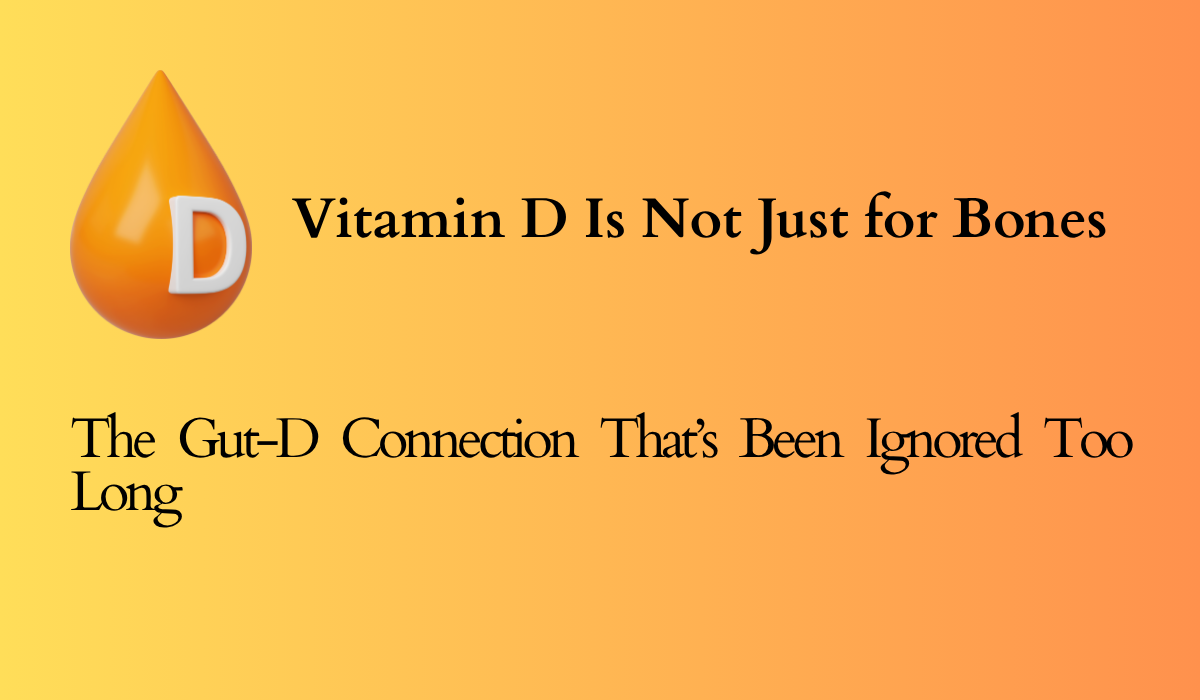In most Indian homes, we’ve grown up hearing the same advice:
“Sit in the sun for 15 minutes, that’s enough Vitamin D.”
“Just pop a supplement if your levels are low.”
And while it’s true that Vitamin D plays a role in bone health, this narrow view is outdated.
Modern research reveals something far more profound: Vitamin D deeply influences your gut health, immune resilience, and even mental clarity. In fact, the symptoms you’re dealing with—bloating, fatigue, fogginess, food sensitivities—might not be fixed with just probiotics or a multivitamin. The missing link could be Vitamin D dysfunction, not just deficiency.
Myth 1: “I Get Enough Sunlight, I Can’t Be Deficient.”
Many Indians assume walking outdoors or sitting in sunlight during daily chores means they’re getting enough Vitamin D. But here’s what most don’t know:
-
Pollution, skin pigmentation, and covered clothing significantly reduce absorption.
-
And even if sunlight touches your skin, if your gut health is poor, your body may not be absorbing or activating Vitamin D efficiently.
So yes—you can be Vitamin D deficient despite spending time outdoors.
Myth 2: “I Take Supplements, So I’m Covered.”
Taking a D3 tablet isn’t always the fix. If your gut isn’t absorbing nutrients properly, that supplement might just pass through.
Common issues include:
-
Low bile flow or gallbladder sluggishness, making it hard to absorb fat-soluble vitamins like D
-
Years of avoiding ghee, oil, or fatty foods for “health” reasons—now backfiring
-
Low stomach acid, often from long-term antacid use, which impairs mineral and Vitamin D uptake
Real-Life Clues That Your Gut Isn’t Using Vitamin D Properly
Even if your test says you’re “in range,” these signs may indicate your body isn’t utilizing it well:
-
Bloating or heaviness after meals, even if you eat light
-
Joint stiffness or aches with no clear arthritis diagnosis
-
Ongoing fatigue, brain fog, or mood dips
-
Food sensitivities that seem to come out of nowhere
It’s not “just aging” or “just stress.” These are signs your Vitamin D–gut axis may be underperforming.
The Science: Vitamin D’s Role in the Gut (Beyond Bones)
Your gut lining has special Vitamin D receptors (VDRs) that regulate:
-
Barrier integrity: Prevents leaky gut and harmful toxins from entering the bloodstream
-
Immune modulation: Supports antimicrobial peptides that fight bad bacteria
-
Inflammation control: Helps reduce chronic, low-grade inflammation
Even your gut microbiome composition shifts based on your Vitamin D status.
Low D levels often mean fewer good bacteria (like Lactobacillus) and more inflammatory strains.
So, Vitamin D isn’t just building bones—it’s building gut resilience.
How to Enhance Vitamin D Absorption – Beyond Just Taking a Tablet
Just taking a supplement is not enough. Your digestion, bile flow, enzymes, and gut lining must work well to absorb and activate Vitamin D.
Here’s how you can enhance absorption naturally:
1. Pair Vitamin D with Healthy Fats – Always
Vitamin D is fat-soluble, so it needs dietary fat to get absorbed.
Best fat pairings:
-
A spoon of ghee with meals
-
Coconut oil, groundnut oil, or cold-pressed sesame oil
-
Soaked almonds, walnuts, or cashews
-
Homemade nut butters, chutneys, or tahini
Avoid: Taking Vitamin D with black coffee, fruit, or cold milk—it reduces uptake.
2. Fix Digestive Issues That Block Absorption
Even the best supplement won’t work if your digestion is compromised.
Common issues:
-
Low stomach acid (from antacid overuse or aging)
➤ Add apple cider vinegar in warm water before meals or use jeera-ajwain-hing mix before eating -
Gallbladder or liver sluggishness (essential for fat digestion)
➤ Sip coriander-fennel-jeera tea, eat methi, bitter greens, and use digestive spices -
Fat malabsorption (in IBS, celiac, liver disorders)
➤ Choose warm, lightly spiced, easy-to-digest meals with moderate healthy fats
3. Choose the Right Form of Vitamin D
Best options:
-
Vitamin D3 (cholecalciferol) over D2
-
D3 with K2 – Helps direct calcium to bones, not arteries
-
Soft gel or oil-based D3 over dry tablets or powders
-
For deficiencies: Consider prescribed high-dose cholecalciferol (e.g., 60,000 IU/week) under medical guidance
Time Your Sun Exposure Right
Best Time: 10 AM – 2 PM
Expose: Face, arms, and legs (at least 25% of the body)
Duration: 15–30 minutes, 3–5 times/week
Avoid sunscreen during this time as it blocks UVB rays
Urban dwellers beware: High pollution, closed spaces, and tinted windows block UV
5. Support the Liver and Kidneys
Vitamin D is converted to its active form in the liver and kidneys.
Liver-friendly foods:
-
Beetroot, amla, bitter gourd, lemon, radish leaves
-
Sip warm lemon water, include turmeric, reduce junk/alcohol intake
If you have kidney concerns, consult your doctor before supplementing.
6. Strengthen Your Gut Microbiome
Vitamin D supports good bacteria—and vice versa.
Feed your gut:
-
Prebiotics: Garlic, onion, raw banana, cooked cooled rice
-
Probiotics: Homemade curd, kanji, fermented pickles (lemon, beetroot), buttermilk
-
Anti-inflammatory spices: Turmeric + black pepper, cinnamon, fennel
7. Test, Track, Tweak
Ideal Vitamin D range: 40–70 ng/mL
Don’t settle for “just above deficiency”—opt for what’s functionally optimal
Retest every 3–6 months and adjust based on symptoms, not just numbers
Quick Absorption Checklist
- Take D3 with good fats (ghee, coconut oil)
- Avoid raw/cold food when supplementing
- Fix gut inflammation & acid balance
- Support liver and gallbladder
- Expose skin to sunlight without sunscreen
- Include probiotics and gut-healing spices
- Track progress with functional testing
Final Thought: Still Think Vitamin D Is Just for Bones?
It’s your gut guardian. Your mood modulator. Your immune compass.
And it’s likely not working properly if your gut isn’t in sync.
Before jumping to more pills or strict elimination diets, start here:
Heal your gut. Optimize your D. Watch your energy, digestion, and mood transform.



